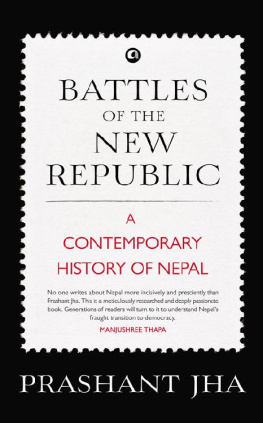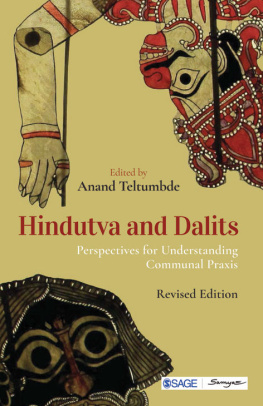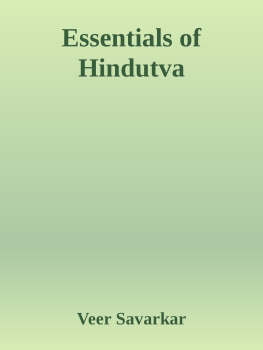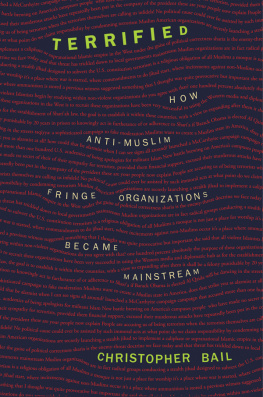JUGGERNAUT BOOKS
KS House, 118 Shahpur Jat, New Delhi 110049, India
First published in hardback by Juggernaut Books 2017
Published in paperback 2019
Copyright Dhirendra K. Jha 2017
10 9 8 7 6 5 4 3 2 1
All rights reserved. No part of this publication may be reproduced, transmitted, or stored in a retrieval system in any form or by any means without the written permission of the publisher.
The views and opinions expressed in this book are the authors own. The facts contained herein were reported to be true as on the date of publication by the author to the publishers of the book, and the publishers are not in any way liable for their accuracy or veracity.
ISBN 9789353450199
Typeset in Adobe Caslon Pro by R. Ajith Kumar, New Delhi
Printed at Manipal Technologies Ltd, India
India has seen astonishing growth in the politics of Hindutva over the last three decades. Several strands of this brand of politics not just the Bharatiya Janata Party (BJP) but also those working for it in the shadows have shot into prominence. They are all fuelled by a single motive: to ensure that one particular community, the Hindus, has the exclusive right to define our national identity. The Rashtriya Swayamsevak Sangh (RSS), a pan-Indian organization comprising chauvinistic Hindu men, is the vanguard of this politics. Formed in 1925, the RSS is not yet a legal entity in so far as it is not registered under any law of the land. Though it claims to be a cultural organization, political motivation has always remained its core concern.
Modelled on the British colonial army, with a similar uniform and training in armed and unarmed combat, and drawing heavily from Benito Mussolinis fascist outfits in Italy, the RSS experienced several ups and downs after Independence. It was banned thrice first for over a year after the assassination of Mahatma Gandhi in 1948, then for nearly two years during the Emergency in the 1970s, and lastly for a few months in the aftermath of the demolition of the Babri Masjid in 1992 but its membership has kept growing.
The RSS network, too, has multiplied steadily. At present, the Sangh has roughly three dozen affiliates across the country. Some of the prominent affiliates are its trade union wing, the Bharatiya Mazdoor Sangh; its students union, the Akhil Bharatiya Vidyarthi Parishad (ABVP); its flamboyant cultural outfit, the Vishwa Hindu Parishad (VHP); and the VHPs youth wing, the Bajrang Dal. The RSS and its various offshoots, collectively known as the Sangh Parivar (the Sangh family), run more than 1,50,000 known projects across India, including tribal welfare, educational and Hindu religious programmes apart from innumerable other projects about which we know little or nothing.
Officially, the BJP is the sole RSS outfit given to politics, but in practice most of its affiliates work as political instruments to turn India into a Hindu Rashtra. They do this in the garb of protecting Hinduism. One could argue that the RSS and the VHP are the biggest shadow organizations of the BJP. Except for contesting elections, they do almost everything a political party would do: mobilize masses, develop issues for political polarization, and play a role in identifying electoral candidates and managing booth-level campaigns. Throughout the research for this book, I was struck by the omnipresence of these pan-Indian outfits. The direct or indirect influence of their members was visible in each of the organizations I chose to study.
Though the RSS publicly eschews politics, as the parent body it not only supplies much of the strategic and ideological direction as well as cadres and leaders to the BJP and other associates, but also has its hand directly or through its affiliates in several communal conflagrations. It is these attacks on minorities that lead to the kind of polarization necessary for the growth of Hindutva politics.
All this is done in a highly equivocal manner. This equivocation can be found everywhere in the Sangh Parivar: in the relationship between the RSS and the BJP, the BJP and the VHP, the VHP and the Bajrang Dal, the BJP and the Hindu Aikya Vedi (HAV), the BJP and the Rashtriya Sikh Sangat, the RSS and the Bhonsala Military School, etc.
Whenever these other bodies create a controversy, the RSS and the BJP promptly label them fringe organizations. The fact, however, is that they are active parts of the Sangh Parivar, working as buffer organizations for doing the dirty work the BJP and the RSS were once obliged to do themselves. The brazen acts required to create polarization in our society are often carried out by these very establishments.
Some of the fringe organizations seem to exist outside the purview of the Sangh Parivar in so far as they are not technically created and controlled by the RSS. Prominent among them are the Sanatan Sanstha, the Hindu Yuva Vahini, the Sri Ram Sene and the Abhinav Bharat. Yet they are not entirely autonomous. Most of them have an umbilical cord attached to the Sangh Parivar, and all of them are ideologically on the same page. Like the RSS and its affiliates, they claim to derive their ideological raison dtre from V.D. Savarkars Hindutva: Who is a Hindu?
Published in 1923, this tract argues that it is Hindutva (Hindu-ness), rather than Hinduism, that constitutes Hindu identity. According to Savarkar, a Hindu is someone who considers Bharat his holy land, carries the blood of the great race of Vedic people, and claims as his own the Hindu Sanskriti. In practical terms, despite their play of words with regard to their ideology, these organizations again like the RSS and its offshoots have interlocked Hindutva and Hinduism, becoming in the end a manifestation of hatred towards minority religious groups, especially Muslims, Christians and Sikhs.
The portrayal of Muslims in particular as threats to Hindus thus justifying the constant attacks on them has remained the single most important tool of all branches of Hindutva politics. Though the practitioners would never say this in public, the objective of these activities is always the same: to create a false fear among Hindus and stoke the polarization of their votes in favour of the party leading the forces of Hindutva.
In the case of the Sikhs, however, persuasion replaces confrontation. The motive of the Sangh Parivar is to kill Sikh identity and amalgamate Sikhism as part of Hinduism. Sikhs are not in the category of the threatening other; they face Hindutva wrath only when they stress on an identity separate from the Hindus.
At first glance, these fringe organizations whether part of the Sangh Parivar or working independently often seem to reflect the ups and downs of local or regional politics. A deeper look, however, would show them as communal eddies generated by the powerful currents of Hindutva politics. The BJPs political evolution from two seats in the Lok Sabha in 1984 to 282 seats in 2014, constituting an absolute majority in the Lower House of Parliament, is not a journey of just one political party it is also the journey of its myriad shadow armies.
Yet, there is little insight into the actual mechanisms that underlie the evolution of these fringe outfits. We do not have a systematic understanding of how they work and how they connect with licit politics. These shadow armies are not direct projections of their pan-Indian partner. Each of them possesses a distinct identity. This book is an attempt to find out the when, the how and the why of these organizations.












